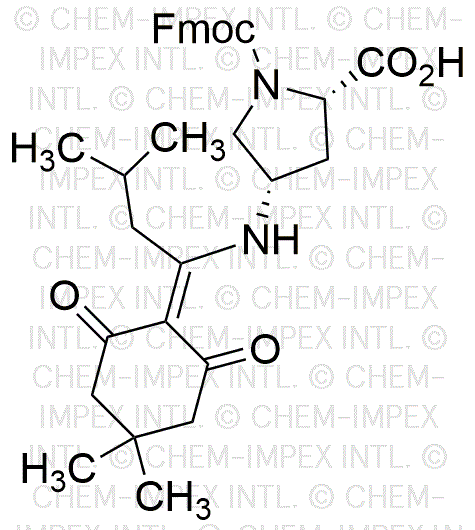N-Fmoc-(4S-NH-(4,4-Dimethyl-2,6-dioxocyclohex-1-ylidene)-3-methylbutyl-L-proline is widely utilized in research focused on:
- Peptide Synthesis: This compound serves as a protective group in solid-phase peptide synthesis, allowing for the selective modification of amino acids without affecting the overall structure. This is crucial for creating complex peptides with specific functions.
- Drug Development: It plays a significant role in the pharmaceutical industry, particularly in designing peptide-based drugs. Its unique structure can enhance the bioavailability and stability of therapeutic peptides, making it valuable in drug formulation.
- Bioconjugation: The compound is used in bioconjugation techniques to link peptides to other biomolecules, such as antibodies or enzymes. This application is essential in developing targeted therapies and diagnostic tools in biotechnology.
- Research in Neuroscience: It is utilized in studies related to neuropeptides, which are crucial for understanding various neurological functions and disorders. The ability to modify neuropeptides can lead to new insights into brain chemistry.
- Material Science: The compound can be incorporated into polymer systems to create smart materials with responsive properties. This application is beneficial in developing advanced materials for sensors and drug delivery systems.
General Information
Properties
Safety and Regulations
Applications
N-Fmoc-(4S-NH-(4,4-Dimethyl-2,6-dioxocyclohex-1-ylidene)-3-methylbutyl-L-proline is widely utilized in research focused on:
- Peptide Synthesis: This compound serves as a protective group in solid-phase peptide synthesis, allowing for the selective modification of amino acids without affecting the overall structure. This is crucial for creating complex peptides with specific functions.
- Drug Development: It plays a significant role in the pharmaceutical industry, particularly in designing peptide-based drugs. Its unique structure can enhance the bioavailability and stability of therapeutic peptides, making it valuable in drug formulation.
- Bioconjugation: The compound is used in bioconjugation techniques to link peptides to other biomolecules, such as antibodies or enzymes. This application is essential in developing targeted therapies and diagnostic tools in biotechnology.
- Research in Neuroscience: It is utilized in studies related to neuropeptides, which are crucial for understanding various neurological functions and disorders. The ability to modify neuropeptides can lead to new insights into brain chemistry.
- Material Science: The compound can be incorporated into polymer systems to create smart materials with responsive properties. This application is beneficial in developing advanced materials for sensors and drug delivery systems.
Documents
Safety Data Sheets (SDS)
The SDS provides comprehensive safety information on handling, storage, and disposal of the product.
Product Specification (PS)
The PS provides a comprehensive breakdown of the product’s properties, including chemical composition, physical state, purity, and storage requirements. It also details acceptable quality ranges and the product's intended applications.
Certificates of Analysis (COA)
Search for Certificates of Analysis (COA) by entering the products Lot Number. Lot and Batch Numbers can be found on a product’s label following the words ‘Lot’ or ‘Batch’.
Número de catálogo
Número de lote/lote
Certificates Of Origin (COO)
This COO confirms the country where the product was manufactured, and also details the materials and components used in it and whether it is derived from natural, synthetic, or other specific sources. This certificate may be required for customs, trade, and regulatory compliance.
Número de catálogo
Número de lote/lote
Safety Data Sheets (SDS)
The SDS provides comprehensive safety information on handling, storage, and disposal of the product.
DownloadProduct Specification (PS)
The PS provides a comprehensive breakdown of the product’s properties, including chemical composition, physical state, purity, and storage requirements. It also details acceptable quality ranges and the product's intended applications.
DownloadCertificates of Analysis (COA)
Search for Certificates of Analysis (COA) by entering the products Lot Number. Lot and Batch Numbers can be found on a product’s label following the words ‘Lot’ or ‘Batch’.
Número de catálogo
Número de lote/lote
Certificates Of Origin (COO)
This COO confirms the country where the product was manufactured, and also details the materials and components used in it and whether it is derived from natural, synthetic, or other specific sources. This certificate may be required for customs, trade, and regulatory compliance.


